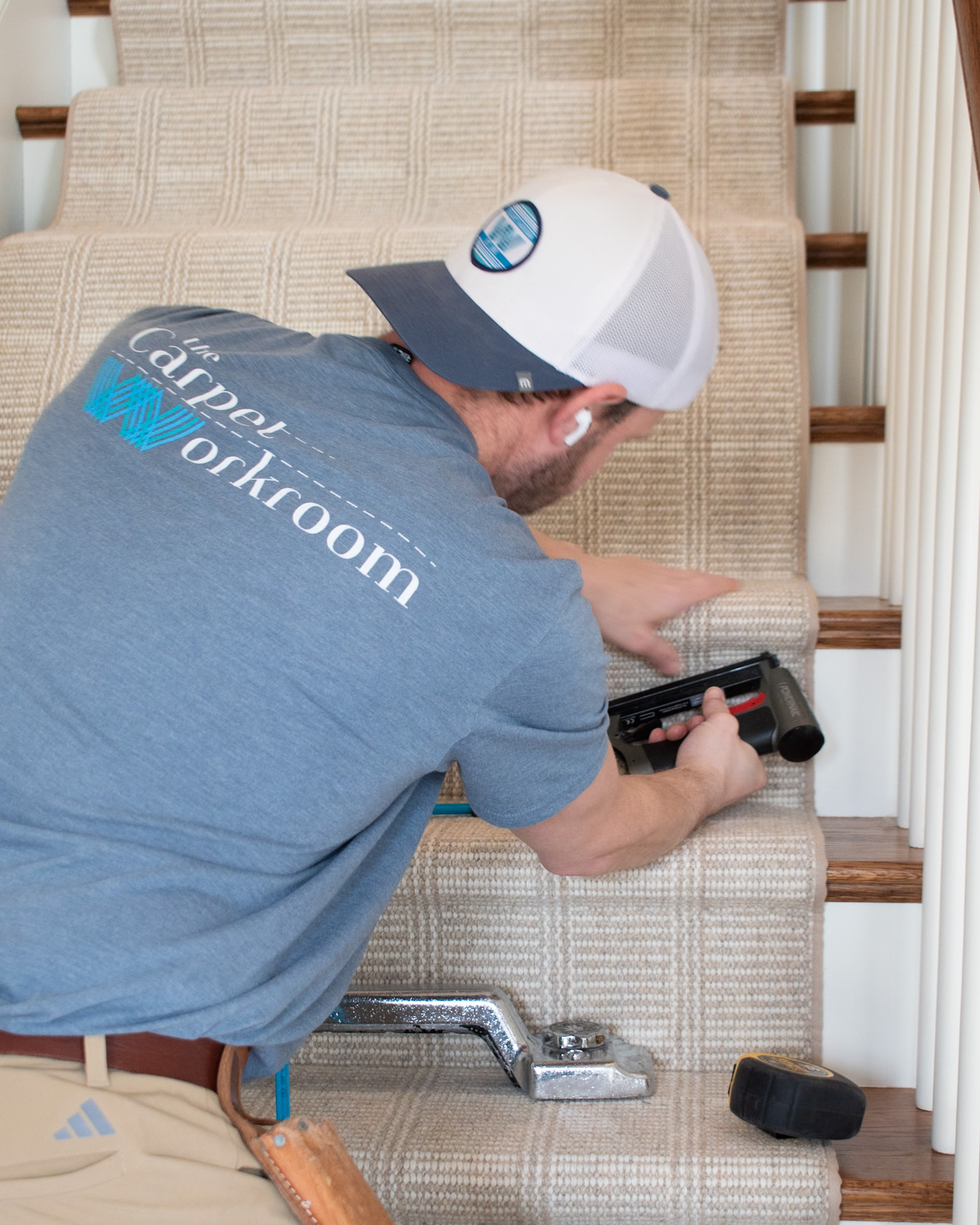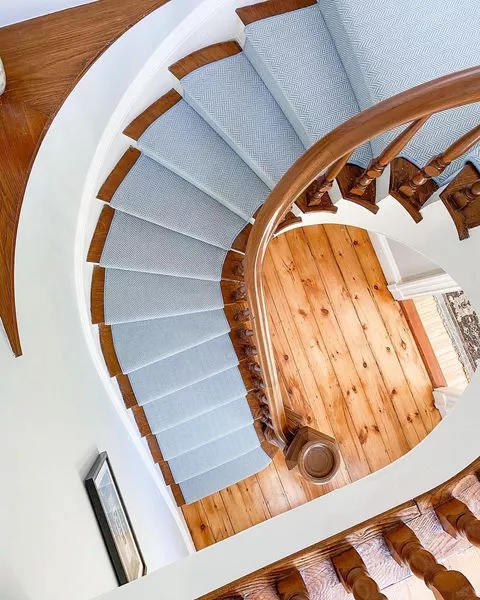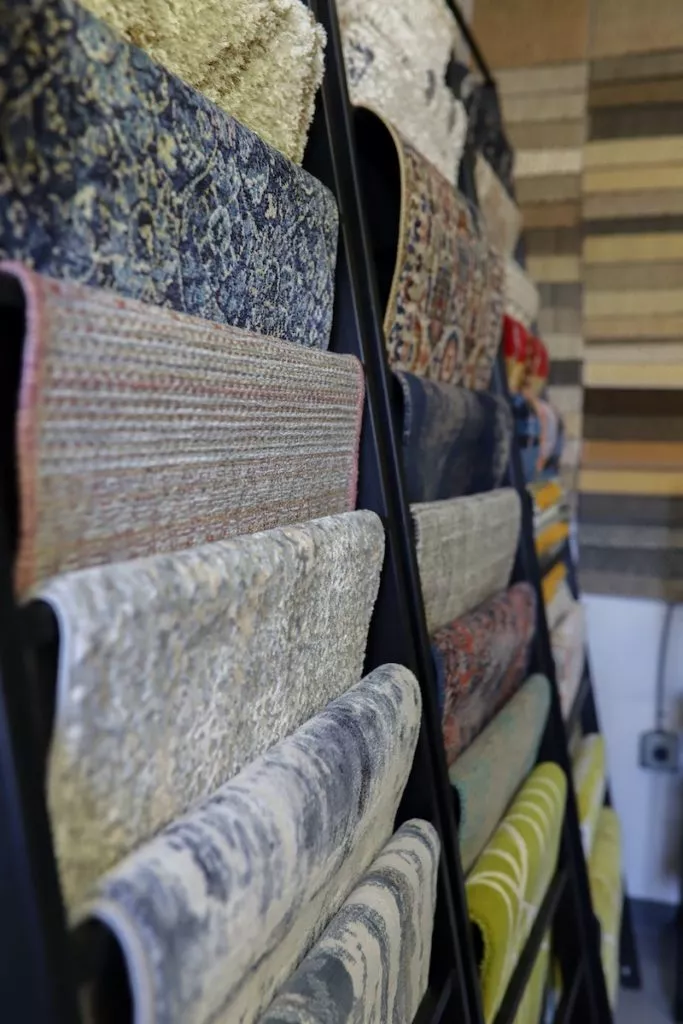At The Carpet Workroom, we’ve seen it all. Whether you’re DIY-ing the design or working with professionals, understanding the most common stair runner mistakes ahead of time can save you time, money, and frustration.
Adding a stair runner is one of the best ways to upgrade your home. It brings together function and design, offering safety, sound absorption, and a stylish focal point that ties everything together. But as simple as it may seem, installing a custom stair runner involves a lot of moving parts—and mistakes can be costly.
Here’s what to look out for—and how to avoid these pitfalls to ensure your project goes smoothly from start to finish.
1. Incorrect Measurements
One of the biggest and most common mistakes is getting the measurements wrong. Stairs may look straightforward, but there’s more to measuring than just counting steps.
What to measure:
- Tread depth (flat part)
- Riser height (vertical part)
- Total number of steps
- Landings or turns
- Desired runner width (usually leaving 3–5 inches of exposed wood on each side)
Missing even one of these can throw off your entire installation. If you have curved or pie-shaped stairs, measuring gets even trickier.
How to avoid it:
Always work with a professional—or at the very least, double-check your measurements with a carpet specialist. At The Carpet Workroom, we verify everything before fabrication begins to ensure a seamless fit.
2. Choosing the Wrong Material for Your Lifestyle
Not all carpets are stair-friendly, and not every style suits every household. A luxurious, plush pile might feel amazing underfoot—but it may not hold up to kids, pets, or heavy traffic.
Common material missteps:
- Choosing a carpet that’s too thick to wrap properly
- Picking a fiber that pills or mats too easily
- Using light colors without considering stains or wear
How to avoid it:
Think about your household’s day-to-day activity. We often recommend wool or wool blends for their durability and natural stain resistance, and flatweaves or indoor/outdoor materials for high-traffic areas or homes with pets.
3. Overlooking Pattern Placement and Flow
A stunning pattern can make a stair runner feel like a piece of art. But if that pattern isn’t aligned properly, it can throw off the entire look.
Pattern issues we see:
- Misaligned stripes or geometrics that feel disjointed
- Ignoring the repeat size, leading to awkward breaks
- Poor transitions at landings or turns
How to avoid it:
Ask how the pattern will flow up your specific staircase. On angled landings, you may need a mitered seam to keep the design continuous. We handle pattern planning and layout carefully at The Carpet Workroom to ensure a cohesive final look.
4. Ignoring Edge Finishing Details
The finishing method might seem like a small detail—but it makes a big difference in the final presentation and durability of your runner.
Common edge mistakes:
- Skipping edge finishing entirely
- Using the wrong type of binding or serging for the material
- Choosing a border color that clashes with the main rug
How to avoid it:
Learn the difference between binding (clean and minimal), serging (stitched and rolled), and wide borders (more decorative and bold). We offer all three at The Carpet Workroom and help clients select the right finish based on style, material, and function.
5. Picking the Wrong Installation Style
There are two main stair runner installation styles—Hollywood and Waterfall—and choosing the wrong one can lead to wrinkles, gaps, or a less-than-polished appearance.
The difference:
- Waterfall: The carpet flows straight from tread to riser, best for plush or thick carpets
- Hollywood: The carpet wraps tightly around the nose of each tread for a tailored look, ideal for flatwoven or low-pile styles
How to avoid it:
Ask your installer which method suits your material and staircase. At The Carpet Workroom, we tailor the installation method to the project—and sometimes use both styles on the same staircase for the best fit.
6. Forgetting About Hallways or Connecting Spaces
It’s easy to focus on the stairs alone and forget what comes next—like the hallway or second flight of stairs. A mismatched or poorly planned transition can break the design flow.
Common slip-ups:
- Ignoring the need for extra material for landings
- Not accounting for hallways that need coordinating runners or rugs
- Missing opportunities to extend the design visually
How to avoid it:
Always look at the staircase in context. We help clients map out their runner design in relation to surrounding rooms and walkways, ensuring the final result feels intentional and cohesive.
7. Underestimating Lead Time
Custom work takes time. One of the most avoidable—but still common—mistakes is starting a stair runner project too close to a move-in date or event.
Why delays happen:
- Material backorders
- Complex pattern layouts or mitered seams
- Fabrication scheduling
- Installation availability
Typical timeline at The Carpet Workroom:
- 2–4 weeks for most projects
- Up to 6 weeks for intricate jobs or peak seasons
How to avoid it:
Plan ahead. Reach out early—especially if you’re working on a deadline. We always walk clients through the expected timeline and keep them updated at every stage.
Final Thoughts: Avoiding the Pitfalls Pays Off
A stair runner isn’t just a functional upgrade—it’s a central design element in your home. With so many small decisions involved, it’s easy to overlook details that can make or break the final result. But with the right guidance and planning, you can avoid the most common stair runner mistakes and end up with a staircase that’s safe, stylish, and built to last.
At The Carpet Workroom, we specialize in custom stair runner design and fabrication. We’ve helped hundreds of homeowners avoid these exact mistakes through thoughtful layout planning, expert craftsmanship, and honest, hands-on guidance. Whether you’re just starting to explore ideas or you’re ready to schedule installation, we’re here to help.Want help getting your stair runner project right the first time?
Visit one of our showrooms in Needham or Stoughton, or email us at info@carpetworkroom.com to schedule a consult.



